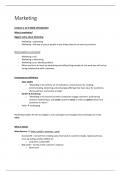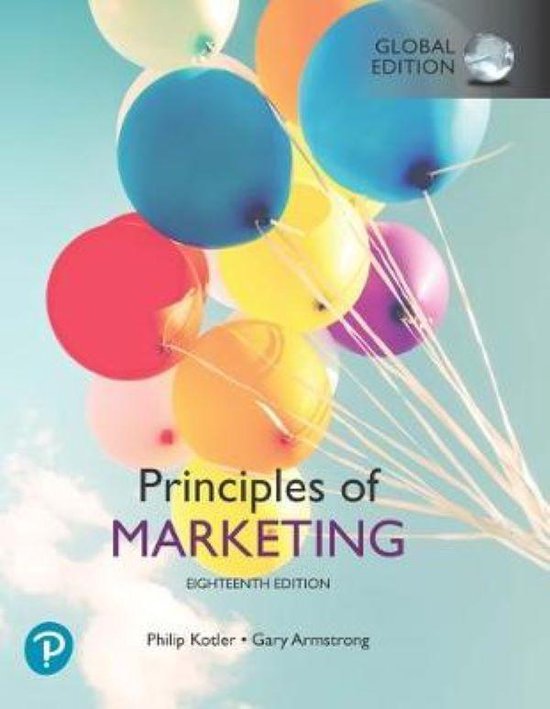Marketing
Lecture 1, 11-4-2023, Introduction
What is marketing?
Biggest myths about Marketing
- Marketing = advertising
- Marketing = the way to pursue people to buy things they do not want to purchase
Misconceptions summarized
- Marketing is evil.
- Marketing is advertising.
- Marketing has an identity problem.
- When you focus to much on advertising and selling things people do not want you will end up
losing (relationship with) customers.
Contemporary definitions
- AMA (2007)
o “Marketing is the activity, set of institutions, and processes for creating,
communicating, delivering and exchanging offerings that have value for customers,
clients partners, and society at large”
- Kortler & Armstrong
o “Marketing is the process by which companies engage customers, build strong
customer relationships, and create customer value in order to capture value from
customers in return.”
- Value → exchanging
Marketing enables the ties to engage in such exchanges and manages those exchanges to create
value
What is Value?
Manufacturer → Value = profit = revenues – costs
- Good profit = earned from creating value that leads to customer loyalty, repeat purchase,
cross up selling, positive WOM, etc.
o Long term, sustainable
- Bad profit = earned at the customer’s expense
o Short term
,Customer → Value = benefits – sacrifice
- Benefits: Economic, function, psychological
- Costs: Sacrifices (money, time, risk)
- Benefits must outweigh the sacrifices
How to create value. 3 options:
- Option 1: Reduce price gap
- Option 2: Private brand
- Option 3: Being innovative (functional). Costs money, is it worth it?
Guest College
Brands create value
- 72% of the test persons would pay +20% to get their favorite brand.
How can you add value? Example milk
- Increase taste experience → verschillende smaken.
- Make it affordable (& makes feel smart) → voordeelpak.
- Makes feel better
- Makes feel healthy
What is marketing about?
- Identify customer needs → market research, analyze market, analyze competitors, what do
customers need?
- Address customer needs
Lecture 2, 13-4-2023, The company and environment
Company objectives, mission, vision and the marketing environment
Company → deliver products/services/value to customers
Companies are there to serve customers, without providing value to customers, there is no company.
You must understand the customers: is your good idea something people want? If you don’t build
relationships with these people, you don’t create value.
Marketing is about relationship making. It’s about people → reaching out/build relationships. If you
don’t understand, other companies will do and take the customers. The more and better you
,understand customers, the better you are off in competition.
Why do companies have mission and vision statements?
- To help guide the different departments in a company (e.g., product development, marketing,
company culture)
- Without the mission/vision statement how will the company develop its offering to the
customer?
- It is like a ship with no destination. A lot of people, without a certain objective, it’s difficult to
assess.
Examples
- Starbucks
o “To inspire and nurture the human spirit – one person, one cup and one
neighborhood at a time.” Hier wordt niks over koffie gezegd. Er is dus veel nuance in
missie en visie statements.
- McDonald’s
o “Our mission is to make delicious feel-good moments easy for everyone.” Hier wordt
niks gezegd over burgers/eten, het is gericht op momenten/gevoelen.
- Q. What is the primary business of Starbucks and McDonald’s?
o Ontroerend goed → ze zitten in grote steden, vliegvelden, stations. Op het goede
moment op de goede plek om mensen een goede ervaring te bieden (a.d.h.v.
koffie/burgers).
- Spotify
o “Our mission is to unlock the potential of human creativity—by giving a million
creative artists the opportunity to live off their art and billions of fans the
opportunity to enjoy and be inspired by it.” Geen aandacht voor gebruikers, maar op
de artiesten. Ook gaat het over kunst, en niet specifiek muziek. Dit doen ze omdat ze
dan vastzitten aan muziek, en hierdoor niet echt andere activiteiten doen.
De missie/visie moet breed genoeg zijn. Anders is er geen ruimte om te groeien als bedrijf.
Why is it important? The objectives, the strategy
- Helps direct the efforts of a company takes across its offerings and market.
- Ansoff’s Matrix (1988)
, - Market Penetration → bestaand product in bestaande markt, lowest risk. Bijv. Pepsi die i.p.v.
een 500ML fles, een liter fles op de bestaande softdrink markt bracht.
- Product development → nieuw product in bestaande markt. Pepsi kers, bestaande markt met
nieuw product met andere smaak.
- Market development → bestaand product in nieuwe markt. Pepsi Max, pepsi bestaat al maar
door max creeren ze een nieuwe markt/nieuw segment.
- Diversification → nieuw product in nieuwe markt. Hoogste risico. Pepsi is eigenaar van
Lays/chips, en dus niet de bestaande softdrink markt.
Macro-environment






